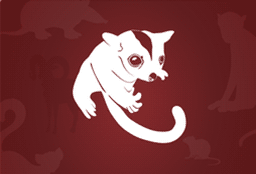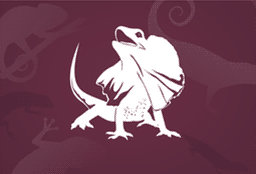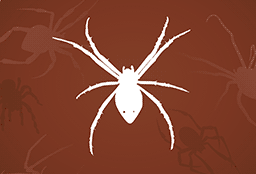Also known as the sandy wallaby, Kimberley wallaby, jungle wallaby, grass wallaby and river wallaby.. A medium-sized, light yellowish-brown with a prominent white face stripe leading back from upper lid to under eye and a white thigh stripe.
Droppings are pear-shaped and slightly pointed at broader end (25 mm long by 15 mm at broadest end).
Size
Body length 80 cm; tail length 77 cm; weight 15 kg.
Black and white, with the pattern varying across its range. The back of its neck, upper tail and shoulders (on its wings) are white in males and grey in females, and (across most of Australia) the rest of its body is black. In south-eastern, central and south-western Australia, including Tasmania, its back and rump are entirely white. Its eye is red-brown. Young birds are usually grey rather than black and have dark eyes.
Distinctive feature
One toe faces backwards and three face forwards. It has a square-tipped tail.
Grey, grey-brown to olive green body with patches of cream. It has black bands running across its body and tail and a "crest" of spines which start on its head and extend down its back and along its tail. Its belly is creamy-white to creamy brown-grey and the larger, breeding males have a red-orange chest and throat. One of two subspecies also has a broad black stripe running from behind its eye to its ear. It has long, powerful legs and a long, strong tail with flattened sides to assist with swimming. There are loose folds of skin under its jaw.
Juveniles are light brown and their head and feet appear large for their body size.
Size
Around 80 - 90 cm long (nose to end of tail) two-thirds of which is tail. Males are bigger than females.
Almost completely black with a rusty-red or chocolate-brown patch at the back of its head and on its neck. Its fur can be tipped with grey, particularly on its belly. It has no fur on its lower legs.
Size
23 – 28 cm head and body length, wingspan over 1 m.
Brahminy kites are medium sized birds of prey common in coastal areas. Adults have an unmistakable white head and chest with a chestnut brown coloured body. They have dark coloured eyes and a strongly hooked, yellow beak. The tail is relatively short and can have white tips.
Size
male 45 cm, female 51 cm with an average wing span of 120 cm
The Bush Stone-curlew has large yellow eyes and long thin legs. Its colouring is mostly grey-brown above, with bold black and rufous streaks. It has buff and white underparts with black streaks. Young birds are similar in colour, but are generally paler.
Distinctive feature
A prominent white eyebrow
Size
54 – 59 cm; wingspan is 82 – 105 cm
Cane toads have tough, leathery skin with a distinctive warty appearance. Usually grey, brown, reddish-brown or yellow in colour with a pale underbelly. Pronounced bony ridge above nostril and venom-producing gland behind the ear (behind the eye).
Juveniles have smooth dark skin with darker blotches and bars. Cane toads sit upright and move in short rapid hops that can help distinguish them from other species. Average-sized adults are 10-15 cm long.
Cane Toad tadpoles are shiny black on top and have a plain dark belly with a short thin tail. They are smaller (less than 3.5 cm) and often gather in huge numbers in shallow waters.
Cane Toad eggs are laid in long strings of transparent jelly enclosing double trows of black eggs. The spawn tangles in dense masses around water plants.
Carpet pythons are extremely variable in colour and pattern (often have pale, dark-edged blotches, stripes or cross bands).
Seven geographical subspecies are recognised as carpet pythons are extremely diverse in appearance. The Northern Territory form (Morelia spilota variegat) is different from the other subspecies because it is a beige or brown colour with blackish or grey blotches and bright gold, yellow and rust colour forms in regional areas. This subspecies is about 2.5m long on average.
They have row of deep pits run along the lower jaw, and small scales present on the top of the head. This species can grow greater than 3 m in length, and although non-venomous, they possess powerful jaws and constricting capability.
Size
2 - 4 m length; 15 kg weight.
The adult male is a distinctive glossy black tinged with iridescent blue and green all over, including its long tail, and it has a striking red eye. The female is glossy brown with white spots on top, and buff-cream underneath with many fine black bars running across its belly. The top of its head is black or brown with pale streaks, and its tail is brown with white bars running across it. A young bird looks like an adult female but has buff barring on its wings and generally much more buff colouring.
The top of the adult male's head is grey-black, extending in a line down either side of its white breast. Its throat is also white, with a rufous patch in the centre. Its wings and lower back are dark metallic grey and its upper back and underneath are buff. In flight, its white outer tail feathers are visible. The female has similar but duller colouring. A young bird has less distinct markings with dark olive on top of its head, a white chin and throat and a cinnamon chest and belly.
Distinctive feature
It has a very long, fine beak that curves downward.
Dark slate-grey on its head, back and wings, and pale orange-brown below; its undertail is boldly barred black and white. Its legs and feet are dull yellow and its bill is black. Young birds are duller and browner, with mottled markings, especially on their breast and underparts.
Distinctive feature
A yellow eye-ring which is tinged green in young birds.
Its genus name Stenocarpus means narrow fruit, referring to its seed pods; and its species name sinuatus means wavy, referring to the edges of the leaves.
Evergreen tree, up to 35 m high, but much smaller when grown in gardens where it reaches a height of only about 10 m with a width of 5 m.
Leaves
Dark glossy green and paler underneath, they can be oval-shaped, lobed or have wavy edges. They are usually 15 – 25 cm long (but can be up to 45 cm long) and 2 – 5 cm wide, and are generally smaller on exposed branches. There is one distinct vein running down the centre of each leaf.
Flowers
Bright red with a yellow tip, and 2.5 – 4 cm long. They cluster in a wheel-like arrangement at the end of a stalk. The cluster can be up to 10 cm in diameter and consists of 6 - 20 flowers.
A grey-brown to orange-brown body, which blends well with tree bark. The frill around its neck is more brightly coloured, ranging from yellow to black, mixed with orange and red. Males have a black belly.
Its frill usually lies folded around its shoulders and neck, but as it is connected to its mouth muscles, when its jaw opens wide (such as in alarm), the frill lifts up around its head. Its body is relatively short with a long neck and tail.
Size
70 – 95 cm long (from its snout to the end of its tail) two-thirds of which is its tail. Males are bigger than females. Its frill is 20 – 25 cm in diameter.
The female’s abdomen can be variable but is typically brown to yellow with short silvery-white hairs. The legs are usually black with bright yellow patches on the underside of the many leg joints. Its palps (small leg-like structures on either side of its fangs) are distinctly red.
It makes golden webs, after which it is named.
Size
Females are 4 – 4.5 cm long but the tiny males are only 5 – 6 mm long (body length). The Females can have a legspan of up to 15 cm!
Deciduous tree, up to 35 m high, but much smaller when grown in gardens and in cooler areas where it reaches a height of only about 10 m. It can take 5 – 8 years to flower if grown from a seed.
Leaves
Smooth, oval-shaped and can have three or five lobes (and sometimes more). Each leaf is 10 – 30 cm long. The tree loses some or all of its leaves at the end of winter, before flowering, and the leaves turn yellow just before falling.
Flowers
Bright coral-red and bell-shaped, they occur in clusters at the end of branches. They are 1 – 2 cm long and have a waxy surface. They appear after the tree has lost all or some of its leaves.
Found in two broad forms. The main form is dark grey to dull blueish-black with numerous, scattered, cream-colored spots. The snout is marked with prominent black and yellow bands extending under the chin and neck. The tail has narrow black and cream bands which are narrow and get wider towards the end of the tail.
The other type, known as Bells form, is typically found in dryer parts of NSW and Queensland. It has broad, black and yellow bands across the body and tail. Close up, these bands are made up of various spotted patterns.
Also known as the Tree Goanna.
Size
About 55cm long (head and body); 140 cm long (head to tail). Some may grow up to 2.1 m long (head to tail).
Predominantly pale tawny-orange with a heavy black border that encloses large white spots in the forewing. The inner leading edge of the forewing is deep red-brown. The underside is similar to the upper side but paler with narrower black margins. Males have a distinct patch of dark grey sex-scales on the upper side of the hindwing.
The caterpillars have three pairs of tentacles and yellow, white and black rings.
Size
7 - 8 cm wingspan.
A black and white bird, the pattern varies slightly between sexes. The male has a white eyebrow above a black horizontal eye-stripe, a black face and throat, while the female has a white face and throat, with a broad vertical stripe through the eye, and no white eyebrow. Both sexes have a thin white bill and black legs and feet. Juvenile Magpie-larks have a black forehead, white eyebrow and a white throat.
The top of its head and its hindneck are black. Its forehead is covered with bright-yellow skin, which hangs down to form wattles. The rest of the head is white. Its back and wings are pale grey-brown. Below, black plumage extends from the hindneck onto the sides of its breast, and the rest of the underparts are white. Its long legs and feet are reddish and its bill is yellow. It has a prominent spur on each wing.
Juveniles are similar to adults, but have dark ‘scallop’ markings on the back and wings, and the wing spur and wattles are either smaller or absent.
Distinctive feature
A yellow wattle that extends from its forehead to behind its eye and hangs down beside its chin.
A medium sized bird with Orange legs and feet. Brown upper wing, head and neck. May have a blue tinted neck. It has a small downwards pointed tail with an orange/yellow beak.
It builds a mound for a nest made of a large heap of mostly decomposing organic matter (leaves, earth, sticks, debris, sand etc) that are circular or elongated.
Distinctive feature
A black crest on the top of the head.
The caterpillar (larva) is initially green, white and brown and resembles bird droppings. A mature caterpillar has a dark brown head, a green body with some pale yellow and brown markings, and spines along its back.
The male butterfly (adult) is black with an arc of creamy-white spots near the tip of each forewing. Each hindwing has a creamy-white patch and a single red spot, and there are many red crescents on its underside.
The female butterfly is brown to black, and the outer half of its forewing is whitish-grey. Its hindwing has a creamy-white patch, as well as a series of blue and red crescent-shaped markings.
Size
Caterpillar up to 6 cm long; Butterflies 10 – 12 cm wingspan.
Black and white, with the pattern varying across its range. The back of its neck, upper tail and shoulders (on its wings) are white in males and grey in females, and (across most of Australia) the rest of its body is black. In south-eastern, central and south-western Australia, including Tasmania, its back and rump are entirely white. Its eye is red-brown. Young birds are usually grey rather than black and have dark eyes.
Distinctive feature
One toe faces backwards and three face forwards. It has a square-tipped tail.
A colourful bird, the upper part of its back is bright green, merging to light blue on the lower part to its rump. Its tail is black, tinged with blue, and has two long central feathers (called streamers) that extend beyond the tip of the tail. Its forehead is blue-green and the top of its head is golden. A bold black eye-stripe runs from the base of its beak and is bordered below by a narrow blue line. Its chin is yellow, changing to chestnut on its throat, below which is a broad black band. It has a green breast, becoming paler on the belly and changing to light blue from the lower belly to the vent. It has a long, slim, curved black beak and its legs and feet are grey-black.
Young birds are generally duller and greener. They lack the black band across the lower throat and the long tail streamers.
Distinctive feature
The sexes differ in the length of their tail streamers: the male has longer, more slender streamers.







